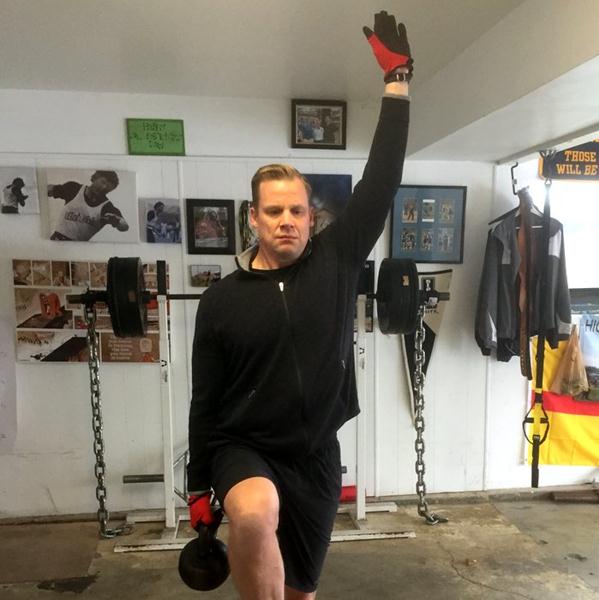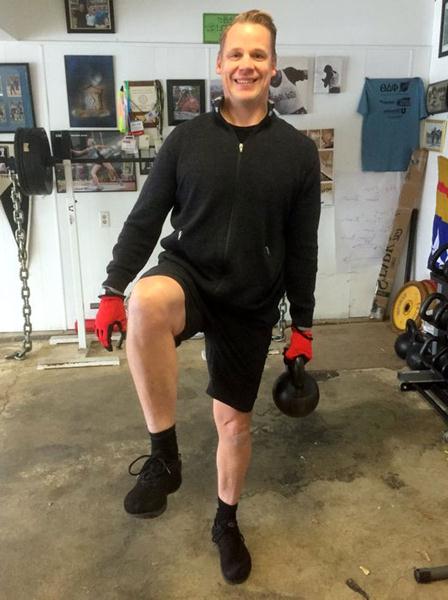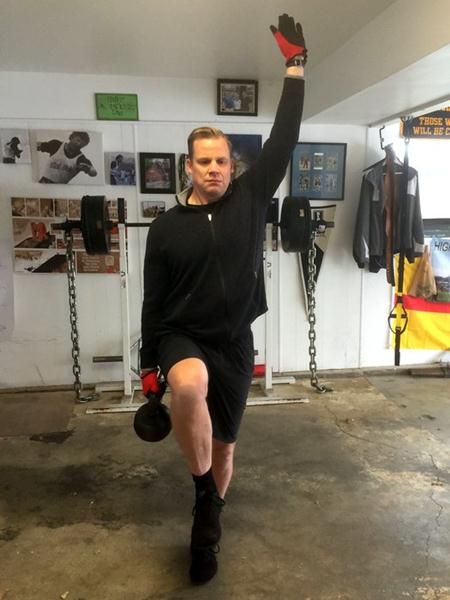Vertical Bird Dog
by Dan John, Master RKC

My brother-in-law, Craig, went to a personal trainer. He had an awful experience. That night, he called to explain what happened. Craig simply said, "He wouldn’t listen."
No matter what Craig or his wife, Marci, tried to tell the trainer, he rejected it and kept repeating his broken record of recommending more sessions and more supplements.
This is a good reminder for all of us. When someone says, "This hurts," what is your response? Do you roll your eyes? Do you mentally ping an offensive slur? Honestly, I have done both, but Craig’s call reminded me—and you—that our clients and athletes come first.
Recently, someone said they don’t do the bird dog exercise because it "bothers their knees." I looked at the concrete floor and thought (for once!), "You know, a pad would work here." But, the pad didn’t solve the problem, and bird dogs still hurt this person’s knees. And with that, I tried to fix it. The fix completely changed the way I coach balance, rotary stability, and how I train the "core."
It’s so simple that I am afraid to give it away too soon. Simply, I call this new variation "vertical bird dogs." That’s right, you can do bird dogs standing up.
Additionally, the vertical bird dog family of exercises addresses a big issue. One of the issues with regular bird dogs is the lack of load. But with vertical bird dogs, we can move our hands and legs in circles or squares, and then pump the elbows to the knees to challenge stability. Use care with the vertical bird dog variations since people will tend to compensate quickly.
True, many have experimented with ankle and wrist weights, but the resulting stress on the joints seems to make this even more painful than bare knees on a cold concrete floor. It shouldn’t come as a surprise to anyone that the load issue is easily solved in the vertical bird dog by holding a
kettlebell.
The Vertical Bird Dog:
I use a series of simple terms in the weight room for clarity. Whenever we practice an exercise on the knees (half kneeling), we always include these terms:
LKD: Left Knee Down
RKD: Right Knee Down
For the vertical bird dog, we add:
LFD: Left Foot Down
RKD: Right Foot Down
If you have coached groups for long enough, you have noticed that when you stand and face the group, your "right" is the group’s left. So, to keep the sequence on track, I recommend two things: ALWAYS do the left side first and the right side second. Feel free to do the opposite, but stick with one pattern. For simplicity in this article, our vertical bird dog series will be discussed only with LFD.
To begin, we instruct everyone to stand on one foot. In my book,
Can You Go?, I note that this is my first assessment. If someone can NOT stand on one foot for ten seconds, I ask them to see a medical doctor before we can continue training. I work with several people who have failed this test, and in every case there has been a cause. As I dealt with a necrotic hip joint, I couldn’t stand for ten seconds—even on my "good" leg. It was obvious that something was wrong with me, and I needed medical intervention. So, the whole group will stand on one foot, then we stop the drill and move on after about thirty seconds.
Next, we add Taylor Lewis’s "stumble drill." Phil Maffetone notes that each year, 28,000 Americans die from falls and fall-related injuries. For years, I taught rolling, tumbling and break-falls to counter this statistic. But, Taylor had a better idea—he advocated teaching people to deal with stumbling. The moment I heard him say "stumble", I wondered how I’d missed something so obvious.
The stumble drill is simple: Touch the shoelaces of your left foot with your right hand. Then, let the right foot swing up. I generally recommend pushing hard with the heel of the right foot straight back. This drill can be a hamstring stretch, a deadlift assistance exercise or a test for "gluteal amnesia." Many people tell me that their butt cheeks feel like they marched up a mountain the next day after practicing this drill. If you have been ignoring proper glute training, you might feel the aftermath of this drill a lot the next day. In addition, we are practicing "not falling," by catching ourselves before we need to break the fall.
After the drill, grab your kettlebell. I recommend men start with a
20kg kettlebell and women begin with a
12kg kettlebell. Throughout the drills, keep the kettlebell in the suitcase carry position ONLY.
In the beginning, marching in place with high knees is great practice before trying the family of vertical bird dog exercises. Marching in place with a kettlebell in the suitcase carry position is also an excellent loaded carry for any training situation with limited space (or for large groups).
Along with swings, goblet squats and push ups, marching in place with a kettlebell in the suitcase carry position might be the "perfect" addition to a group training sequence.
Now, let’s discuss the vertical bird dog family of drills.
LFD (left foot down) with the kettlebell in the left hand:

This variation will be relatively easy since the weight will be countered by the body mass in this position. Bring the right knee up to at least a 90-degree angle, but feel free to pull it higher.
Switch hands.
LFD (left foot down) with the kettlebell in the right hand:
Now, the kettlebell and body mass are on the same side, so balance will be compromised. The resulting wiggling will completely awaken the entire core of the body. Many people report odd soreness the next day in the lats and obliques since these muscles will try to adjust and compensate to the demands of balance.
Now for the fun part, vertical bird dogs:
LFD (left foot down) Bird Dog
With the kettlebell in the left hand, extend the right hand to the zenith. Really drive the middle finger (insert standard joke: important for driving in Utah!) towards the stars. The right knee should come up to 90. Now, you are in the traditional bird dog position, except that you are standing up.
You still gain all the benefits of the bird dog family (rotary stability probably comes to mind first), but with added bonuses of a balance challenge and dealing with weight.
LFD Single Side Bird Dog

Hold the kettlebell in the right hand. Now, things get difficult. With the left hand extended to zenith, both the body mass and kettlebell load will be pulling hard to the right. The left foot will be actively squeezing, releasing and struggling to keep the body upright. If you can hold the stance for a while, the core work will be amazing.
Recently, we’re hearing the word "activating" a lot in the fitness industry, and the vertical bird dog family of drills certainly teaches the activation of every stabilizer—essentially every muscle.
Now, simply perform the series with the RFD (right foot down).
The vertical bird dog drills can certainly be practiced daily. One interesting thing, when I moved up to using my
28kg kettlebell (the first kettlebell I ever had, my "Old Blue," my favorite bell) for the vertical bird dog series, the amount of work necessary to do each drill LEAPED up. So, just like standard weight training, the vertical bird dog follows the laws of progressive resistance exercise.
Traditional bird dogs drills have been a standard in my gym and will remain in our training. But, "listening" to the issue of hard floors had me thinking in a direction that will benefit every trainee from elite athlete to the nice grandpa next door.
You must listen to your trainees if you want to be an elite trainer and coach.
 Master RKC, Dan John is the author of numerous fitness titles including the best selling Never Let Go and Easy Strength. Dan has spent his life with one foot in the world of lifting and throwing, and the other foot in academia. An All-American discus thrower, Dan has also competed at the highest levels of Olympic lifting, Highland Games and the Weight Pentathlon, an event in which he holds the American record.
Master RKC, Dan John is the author of numerous fitness titles including the best selling Never Let Go and Easy Strength. Dan has spent his life with one foot in the world of lifting and throwing, and the other foot in academia. An All-American discus thrower, Dan has also competed at the highest levels of Olympic lifting, Highland Games and the Weight Pentathlon, an event in which he holds the American record.
Dan spends his work life blending weekly workshops and lectures with full-time writing, and is also an online religious studies instructor for Columbia College of Missouri. As a Fulbright Scholar, he toured the Middle East exploring the foundations of religious education systems. For more information visit: danjohn.net
Register for the Upcoming 2016 San Jose, California RKC taught by Master RKC Dan John with Master RKC Chris Holder, and RKC Team Leader Chris White
In the photos: Brian Deede was outside linebacker for Ball State for four years as a starter and three-year letterman.
Back